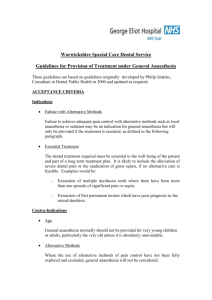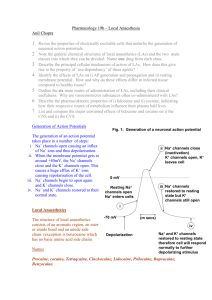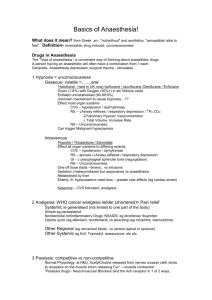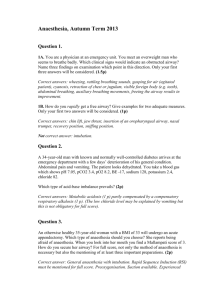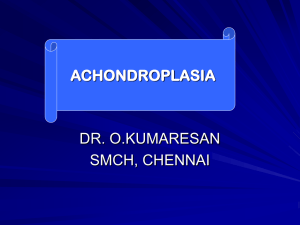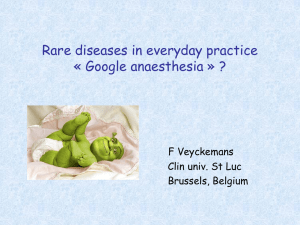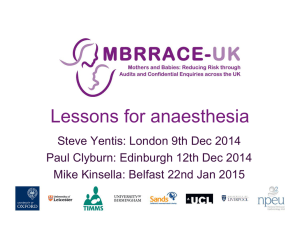COURSEWARE - University of Ilorin
advertisement
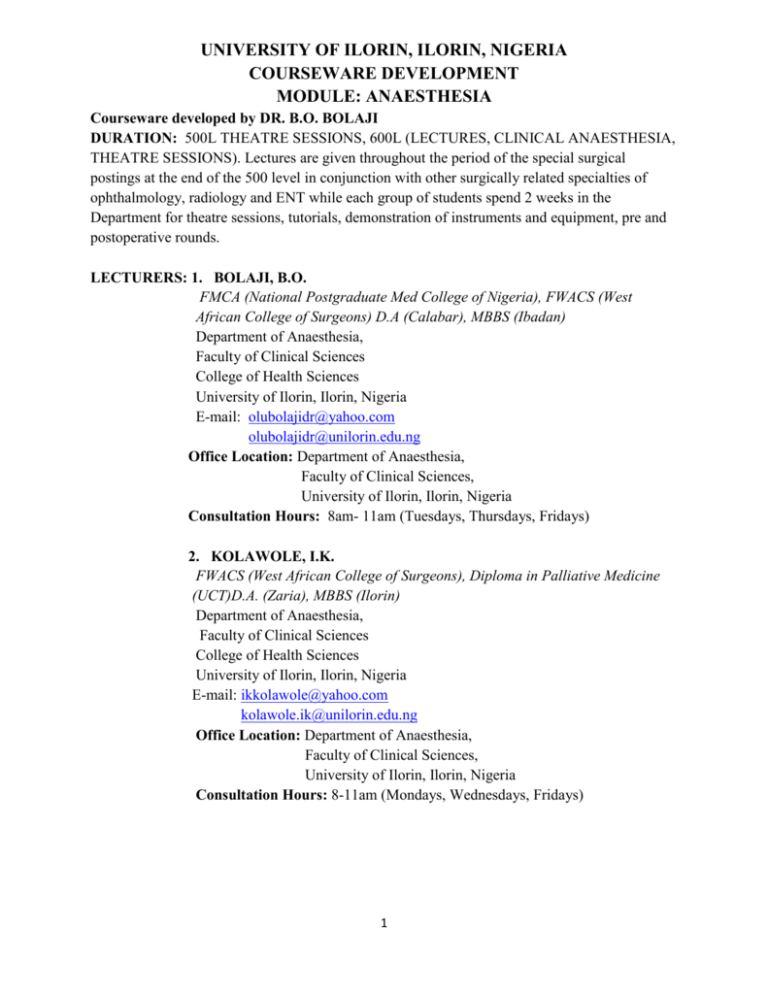
UNIVERSITY OF ILORIN, ILORIN, NIGERIA COURSEWARE DEVELOPMENT MODULE: ANAESTHESIA Courseware developed by DR. B.O. BOLAJI DURATION: 500L THEATRE SESSIONS, 600L (LECTURES, CLINICAL ANAESTHESIA, THEATRE SESSIONS). Lectures are given throughout the period of the special surgical postings at the end of the 500 level in conjunction with other surgically related specialties of ophthalmology, radiology and ENT while each group of students spend 2 weeks in the Department for theatre sessions, tutorials, demonstration of instruments and equipment, pre and postoperative rounds. LECTURERS: 1. BOLAJI, B.O. FMCA (National Postgraduate Med College of Nigeria), FWACS (West African College of Surgeons) D.A (Calabar), MBBS (Ibadan) Department of Anaesthesia, Faculty of Clinical Sciences College of Health Sciences University of Ilorin, Ilorin, Nigeria E-mail: olubolajidr@yahoo.com olubolajidr@unilorin.edu.ng Office Location: Department of Anaesthesia, Faculty of Clinical Sciences, University of Ilorin, Ilorin, Nigeria Consultation Hours: 8am- 11am (Tuesdays, Thursdays, Fridays) 2. KOLAWOLE, I.K. FWACS (West African College of Surgeons), Diploma in Palliative Medicine (UCT)D.A. (Zaria), MBBS (Ilorin) Department of Anaesthesia, Faculty of Clinical Sciences College of Health Sciences University of Ilorin, Ilorin, Nigeria E-mail: ikkolawole@yahoo.com kolawole.ik@unilorin.edu.ng Office Location: Department of Anaesthesia, Faculty of Clinical Sciences, University of Ilorin, Ilorin, Nigeria Consultation Hours: 8-11am (Mondays, Wednesdays, Fridays) 1 3. OYEDEPO, O.O. FMCA (National Postgraduate Med College of Nigeria), MBBS (Ilorin), B.Sc (Ilorin) Department of Anaesthesia, Faculty of Clinical Sciences College of Health Sciences University of Ilorin, Ilorin, Nigeria E-mail: droyedepo@yahoo.com oyedepo.oo@unilorin.edu.ng Office Location: Department of Anaesthesia, Faculty of Clinical Sciences, University of Ilorin, Ilorin, Nigeria Consultation Hours: 8-11am (Mondays, Wednesdays and Fridays) 4. SULEIMAN, Z.A. FWACS (West African College of Surgeons), MBBS (Zaria) Department of Anaesthesia, Faculty of Clinical Sciences, College of Health Sciences University of Ilorin, Ilorin, Nigeria E-mail: suleiman.za@unilorin.edu.ng suzack71@yahoo.com Office Location: Department of Anaesthesia, Faculty of Clinical Sciences, University of Ilorin, Ilorin, Nigeria Consultation Hours: 8-11am (Mondays, Tuesdays and Fridays) 5. IGE, O.A. FWACS (West African College of Surgeons), MBBS (Benin) Department of Anaesthesia, Faculty of Clinical Sciences, College of Health Sciences University of Ilorin, Ilorin, Nigeria E-mail: ige.oa@unilorin.edu.ng femiigedoc@yahoo.com Office Location: Department of Anaesthesia, Faculty of Clinical Sciences, University of Ilorin, Ilorin, Nigeria Consultation Hours: 8-11am (Mondays, Wednesdays and Fridays) 2 Course Content- Didactic lectures Introduction to anaesthesia. History of Anaesthesia, Pre-operative assessment, premedication and premedicant drugs, Intravenous anaesthetic agents- thiopental, methohexital, etomidate, ketamine, propofol, midazolam. Inhalational anaesthetic agents- uptake & distribution. nitrous oxide, ether, halothane and other halogenated hydrocarbons. Physiology of neuromuscular transmission. Types of neuromuscular block. Neuromuscular blocking agents- suxamethonium, tubocurarine, pancuronium, atracurium, vecuronium etc, factors affecting neuromuscular block, reversal of neuromuscular paralysis. Practical conduct of anaesthesia. Routes of induction of anaesthesia. Airway management- endotracheal intubation. Intraoperative monitoring. Perioperative fluid therapy (crystalloids, colloids) and blood transfusion, massive blood transfusion. Complications of blood transfusion. Postoperative care. Complications in the Postanaesthetic Care Unit. Postoperative pain and management. Anaesthesia for emergency surgerychallenges and preparation. Mendelson’s syndrome- predisposing causes, prevention, diagnosis and management. Pain, acute and chronic. Pathophysiology, assessment and management . Oxygen transport. Respiratory failure- aetiology, diagnosis and management. Oxygen therapydevices and complications of oxygen therapy. Cardiac arrest. CPR. Neonatal resuscitation. Obstetric analgesia and anaesthesia. Paediatric anaesthesia. Anaesthesia in the presence of some surgical and medical conditions- hypertension, diabetes mellitus, thyrotoxicosis, haemoglobinopathy, asthma, typhoid perforation, intestinal obstruction. Pharmacology of local anaesthetic agents- esters and amides. Local anaesthetic techniques- nerve blocks, brachial plexus block, Bier’s technique, subarachnoid, epidural, caudal. The Intensive Care Unitorganization and management. Care of the unconscious patient. Invasive monitoring- CVP, intraarterial monitoring, arterial blood-gas analysis. Nutrition in the critically ill- enteral feeding, total parenteral nutrition (indications, techniques and complications). Course Content- Clinical Anaesthesia for patients in general surgery, ENT, obstetrics and gynaecology, paediatric surgery, plastic surgery, cardiothoracic surgery, orthopaedic surgery, neurosurgery, urological surgery and ophthalmology. Pre-operative ward rounds (history taking, physical examination, relevant investigations) and premedication. Intra-operative management of patients (general anaesthesia, regional techniques, plexus and nerve blocks). Airway management and ventilation. Recovery room care. Postoperative care- monitoring, pain management etc. Management of critically ill and other patients in the Intensive Care Unit. Course Justification Good surgical outcome depends on sound scientific knowledge of anaesthesia which includes physiology, anatomy, pharmacology and clinical medicine related to the specialty. Pain is the most common presenting symptom of patients and this is a specialized area in anaesthesia in which the student must have basic knowledge. Critical care involves airway management, support of the respiration and circulation for which the student must also have a sound knowledge in order to be able to manage such patients upon graduation. 3 Course Objectives in Anaesthesia At the end of period in anaesthesia posting, the student should: a) have sound knowledge of and be able to perform life support procedures; viz: respiratory resuscitation, cardiopulmonary resuscitation, care of the unconscious patient, other resuscitative measures. b) have a sound knowledge of and be able to enumerate the general principles of operative anaesthesia c) be able to provide peri-operative care d) be able to perform some regional anaesthetic techniques e) be able to give a general anaesthetic for minor surgical procedures f) recognize high risk surgical patients g) demonstrate basic skills in the management of common complications of anaesthesia h) be able to assess and manage acute and chronic pain i) demonstrate basic knowledge for provision of labour analgesia WEEK 1: INTRODUCTION TO ANAESTHESIA. LECTURER: DR B.O. BOLAJI Overview of historical landmarks in Anaesthesia. Types of Anaesthesia Stages of Anaesthesia Triad of Anaesthesia PREOPERATIVE ASSESSMENT. LECTURER: DR B.O. BOLAJI objectives History, physical examination, investigations, risk assessment. PREMEDICATION AND DRUGS USED FOR PREMEDICATION LECTURER: DR. B.O. BOLAJI Objectives Classification of premedicant drugs Drugs used for premedication- pharmacology, clinical uses Week 1 theatre sessions/tutorials/equipment 8am-1pm Mon-Fri: ALL LECTURERS Week 1 Study Questions 1. What is the triad of anaesthesia? List two agents that can be used to achieve each component of the triad 2. What are the objectives of preoperative assessment? 3. What is premedication? What are the objectives of premedication? 4. What is the ASA classification? 5. List the anticholinergic agents used in anaesthesia. In a tabular form list their actions on the central nervous and the cardiovascular system. 4 WEEK 2 INTRAVENOUS ANAESTHETIC AGENTS. LECTURER: DR Z. A. SULEIMAN Pharmacokinetics Ideal iv anaesthetic agents Classification Pharmacology-Thiopental, methohexital, etomidate, ketamine, propofol, midazolam WEEK 2: INHALATIONAL ANAESTHETIC AGENTS. LECTURER: DR. O.O. OYEDEPO Uptake and distribution Physical characteristics- MAC, solubility coefficients Ideal inhalational anaesthetic agents Pharmacology, uses- N2O, ether, halothane and other halogenated hydrocarbons Classification of inhalational anaesthetic agents Administration, vapourizers Week 2 theatre sessions/tutorials/equipment 8am-1pm Mon-Fri: ALL LECTURERS Week 2 Study Questions 1. Define an intravenous anaesthetic agent 2. List 10 characteristics of an ideal intravenous anaesthetic agent 3. Write short notes on halothane and isoflurane 4. In a tabular form list 5 differences between ketamine and thiopentone 5. What is minimum alveolar concentration? 6. Enumerate factors that determine uptake and distribution of inhalational anaesthetics WEEK 3: NEUROMUSCULAR BLOCKADE IN ANAESTHESIA . LECTURER: DR O.A. IGE Physiology of neuromuscular transmission. Types of block. Neuromuscular blocking agents- suxamethonium, tubocurarine, pancuronium, atracurium, vecuronium etc. Monitoring of neuromuscular blockade Reversal of neuromuscular blockade- anticholinesterases Factors affecting blockade and reversal Week 3 theatre sessions/tutorials/equipment 8am-1pm Mon-Fri: ALL LECTURERS Week 3 Study Questions 1. In a tabular form, list the differences between depolarizing and non-depolarizing block 2. List FIVE complications of suxamethonium administration 3. List three clinical assessments used to ascertain adequacy of reversal of neuromuscular block 5 WEEK 4: PRACTICAL CONDUCT OF ANAESTHESIA. LECTURER: DR. I.K. KOLAWOLE Routes of induction of anaesthesia. Airway management. Endotracheal tubes and intubation- indications, complications. Postoperative care Complications in the post-anaesthetic care unit Week 4 theatre sessions/tutorials/equipment 8am-1pm Mon-Fri: ALL LECTURERS Week 4 Study Questions 1. What are the routes of induction of anaesthesia. Give 2 examples for each route 2 What are the indications for endotraecheal intubation? 3 List five (5) early complications of endotracheal intubation. 4 List FIVE complications that can occur in the immediate postoperative period 5. List THREE supraglottic and TWO infraglottic airway devices 6. List FIVE signs of inadequate analgesia under general anaesthesia WEEK 5: LOCAL ANAESTHETIC AGENTS. LECTURER: DR. Z. SULEIMAN History Mechanisms of action Classification- esters and amides Pharmacology- cocaine, chloroprocaine, amethocaine, etidocaine, lidocaine, bupivacaine ropivacaine Clinical applications WEEK 5. LOCAL ANAESTHETIC TECHNIQUES. LECTURER: DR. Z SULEIMAN Nerve blocks, digital block Field block e.g. for inguinal herniorrhaphy Brachial plexus block Bier’s block Week 5 theatre sessions/tutorials/equipment 8am-1pm Mon-Fri: ALL LECTURERS Week 5 Study questions 1. What are the mechanisms of local anaesthetic agents? 2. List 4 differences between amides and esters. 3. What are the physical characteristics of LAs that affect onset, potency and duration 4. List the toxic effects of local anaesthetic agents 5. List the complications associated with interscalene block 6. What nerves are blocked during field block for inguinal herniorrhaphy 6 WEEK 6. CENTRAL NEURAL AXIAL BLOCKADE. LECTURER: DR. I.K. KOLAWOLE Anatomy- vertebrae, epidural space, sacral hiatus Contraindications to central neural axial blockade Subarachnoid block Epidural block Caudal block Local anaesthetic agents used for central neural axial blockade Complications of central neural axial blockade WEEK 6: MONITORING IN ANAESTHESIA. LECTURER: DR. O.A. IGE Monitors- types Monitoring of patients under anaesthesia Monitoring of ICU patients- invasive and non-invasive Arterial blood gas analyses Week 6 theatre sessions/tutorials/equipment 8am-1pm Mon-Fri: ALL LECTURERS Week 6 Study Questions 1. What is caudal anaesthesia? List five (5) indications of caudal anaesthesia 2. What is spinal anaesthesia? List ten (10) contraindications to spinal anaesthesia. 3. List four parameters which can be monitored in the cardiovascular system 4. List four indications for arterial canulation 5. In a tabular form, list FIVE differences between epidural and subarachnoid blocks WEEK 7. PERIOPERATIVE FLUID THERAPY. LECTURER: DR. O.O. OYEDEPO Crystalloids and colloids Fluid deficit, intraoperative maintenance and ongoing losses Intaoperative blood loss, assessment Intraoperative blood transfusion, massive blood transfusion and complications of blood transfusion. WEEK 7: PAIN I: ACUTE PAIN. LECTURER: DR I.K. KOLAWOLE Introduction to pain, anatomy Pathophysiology of acute pain Assessment of acute pain and management Postoperative pain- incidence, factors affecting, management Consequences of unrelieved pain Barriers to pain control- opioids and non-opioid analgesics Adjuvant in pain management Week 7 theatre sessions/tutorials/equipment 8am-1pm Mon-Fri: ALL LECTURERS 7 Week 7 Study Questions 1. What is pain? What are the consequences of unrelieved postoperative pain. 2. Describe the WHO Analgesic ladder 3. List FIVE methods of postoperative pain relief 4.In a tabular form, list the differences between crystalloids and colloids 5. What is massive blood transfusion? List the complications. WEEK 8: ANAESTHESIA FOR EMERGENCY SURGERY. LECTURER: DR O.O. OYEDEPO Challenges and preparation Acid aspiration prophylaxis Techniques of anaesthesia- Regional, General (rapid sequence induction) Mendelson’s syndrome- predisposing conditions, prevention, diagnosis and management WEEK 8. PAIN II- CHRONIC PAIN. LECTURER: DR Z.A. Suleiman Pathophysiology Factors predisposing Assessment and diagnosis of chronic pain Management of chronic pain Week 8 theatre sessions/tutorials/equipment 8am-1pm Mon-Fri: ALL LECTURERS Week 8 Study Questions 1. What is Mendelson’s syndrome. List FIVE features of the syndrome 2. List FIVE methods that can be used to prevent acid aspiration preoperatively 3. Outline management of a 65 year old woman with chronic back pain. WEEK 9. OXYGEN THERAPY. LECTURER: DR. O.A. IGE Oxygen transport, oxygen flux, oxy-haemoglobin dissociation curve Respiratory failure- aetiology, diagnosis and management. Oxygen therapy. Devices used for oxygen therapy- variable and fixed performance Complications of oxygen therapy. WEEK 9: CARDIOPULMONARY RESUSCITATION. LECTURER: DR. B.O. BOLAJI Cardiac arrest- definition Causes of cardiac arrest Chain of Survival Basic life support- definition, practice with manikins Advance life support Defibrillation 8 Week 9 theatre sessions/instruments/equipment 8am-1pm Mon-Fri: ALL LECTURERS Week 9 Study Questions 1. List five aetiological factors in respiratory failure 2. What are the complications of oxygen therapy? 3 Define cardiac arrest 4 List the features of cardiac arrest 5 What are the components of Basic Life Support 6. List FIVE contents of the resuscitation trolley WEEK 10. OBSTETRICS ANALGESIA AND ANAESTHESIA. LECTURER: DR. I.K. KOLAWOLE Physiology of pregnancy- implications for anaesthesia Non-pharmacological methods of labour analgesia Systemic analgesia in labour Regional analgesia in labour Anaesthesia for obstetrics- general, subarachnoid block, epidural WEEK 10. PAEDIATRIC ANAESTHESIA. LECTURER: DR. O.O. OYEDEPO Anatomy and physiology in child- implications for anaesthesia Equipment for paediatric anaesthesia- e.g. Jackson Rees’ modified Ayre’s T-piece Intraoperative fluid therapy, drug dosages Caudal block Week 10 theatre sessions/instruments/equipment 8am-1pm Mon-Fri: ALL LECTURERS Week 10 Study Questions 1. List the consequences of unrelieved pain in labour. 2. List the pharmacological methods of pain relief in labour. 3 What is postoperative croup? Outline its management. 4 List FIVE differences between pediatric and adult airway WEEK 11. ANAESTHESIA IN THE PRESENCE OF SOME MEDICAL AND SURGICAL CONDITIONS. LECTURER: DR. O.O. OYEDEPO Hypertension Diabetes mellitus Thyrotoxicosis Haemoglobinopathy Asthma Intestinal obstruction 9 WEEK 11: INTRODUCTION TO INTENSIVE CARE. LECTURER: DR. O.A. IGE Organization of ICU Indications for admission into ICU Resuscitation of critically ill patients Week 11 theatre sessions/tutorials/equipment 8am-1pm Mon-Fri: ALL LECTURERS Week 11 Study Questions 1. Outline the preanaesthetic preparation of a controlled hypertensive patient scheduled for prostatectomy under general anaesthesia 2. What is thyroid storm? How can it be diagnosed under general anaesthesia? 3. List THREE features of an intensive care unit 4. What are the indications for ICU admission? 5. Outline the treatment of bronchospasm occurring under general anaesthesia in an asthmatic patient WEEK 12: INTRODUCTION TO ICU II. LECTURER: DR. O.A. IGE Organ support- mechanical ventilation Nutrition in the critically ill- enteral, parenteral, complications Care of the unconscious patient Week 12 theatre sessions/tutorials/equipment 8am-1pm Mon-Fri: ALL LECTURERS Week 12 Study Questions 1. List FIVE indications for parenteral nutrition 2. What are the complications of parenteral nutrition? 3. List FIVE methods of maintaining the airway of an unconscious patient WEEK 13. PRACTICAL SESSIONS ON EXAMINATIONS. ALL LECTURERS Demonstration of clinical pictures in anaesthesia Training on Objective Structured Clinical Examination Week 13 theatre sessions/tutorials/equipment 8am-1pm Mon-Fri: ALL LECTURERS WEEK 14. REVISION. ALL LECTURERS WEEK 15. END OF POSTING EXAMINATION GENERAL READING LIST: 1. Aitkenhead1 AR, Smith G(1998). Textbook of Anaesthesia, 3rd ed. London, Harcourt Brace and Company Ltd 2. Akpan2 SG, Eshiet AI, Ilori IU, Kalu Q (2008). Basic Principles of Anaesthesia for Medical Students. Calabar, Optimist Press Nigerian Company. 3. Allman3 KG, Wilson IH. Oxford Handbook of Anaesthesia, 2nd edition. Oxford, Oxford University Press 4. Churchill-Davidson4 HC (1984). Wylie and Churchill-Davidson’s A Practice of Anaesthesia, 10 5th edition. Chicago, Year Book Medical Publishers Inc. 5. Elegbe5 EO (2007). Handbook of Anaethetics for Medical Students and General Medical Practitioners, New Edition. Ibadan, HEBN Publishers. 6. Famewo6 CE (1994). Lecutres in Anaesthesia and Intensive Care for Medical Students and Practitioners, 2nd edition. Ibadan, Les Shyraden (Nig) Ltd. 7. Morgan7 GE (JNR), Mikhail MS, Murray MJ (2006). Clinical Anaesthesiology, 4th Edition. New York, Lange Medical Books/McGraw-Hill Medical Publishing Division LEGEND 1 - Available in College of Health Sciences Library 2 - Available in Department Library 3 - Available in Department Library 4 - Available in College of Health Sciences Library 5 - Available in Department Library 6 - Personal collection 7 - Personal collection 11


